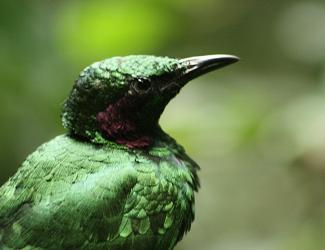Type the name of the breed you're looking for below
[wpdreams_ajaxsearchlite] Don't see the breed your're looking for? Click here and let us know!
Emerald Starling
| Origin | One of the smallest species among starlings, the Emerald starling is distributed in West Africa. It inhabits lowlands and savannah of Côte d'Ivoire, Guinea and Sierra Leone. |
| Size | Can grow up to 8 in(20 cm) |
| Lifespan | Can live 10+ years |
| Noise | Moderate, especially when kept in groups. |
| Characteristics | It is a small starling with a metallic green crown, upper body, wings and tail. The ear-coverts and underparts are metallic purple. Both sexes are similar. The emerald starling feeds on figs, Haronga berries and other fruit, seeds, ants and other small insects. The cup-shaped nest is built in a tree cavity. The male and female cooperate in building the nest from leaves, and both bring food to chicks after they hatch. Females possess a brood patch—a spot on their stomach lacking feathers—that helps them transfer body heat to their eggs. |
| Interaction/Time Requirements, Diet, Supplies Needed | The Emerald starling feeds on figs, Haronga berries and other fruit, seeds, ants and other small insects. You need to change food and water daily, and clean the cage at least once a day, replacing toys and broken climbing branches. The cup-shaped nest is built in a tree cavity. Space is important and indoor cages should be as large as possible. A large cage is required even if the bird is going to spend lots of time out of its habitat with you. Aviaries are sold ready for home assembly. Most are a rectangular design, with a mesh covered flight, and smaller shelter area, in which the birds are fed and can take shelter from the bad weather. They require a warm habitat for the winter months. Do not allow your birds outdoors until all signs of frost are gone. A minimum of 12 inches long, 14 inches wide, and 12 inches high. |



